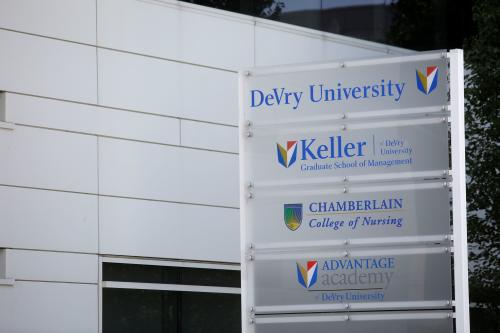As for-profit colleges ramp up their advertising to attract students and laid-off workers stuck at home during the COVID-19 pandemic, a new report from the Brown Center on Education Policy at Brookings offers new, salient insights on the multimillion-dollar world of college advertising. Authors Stephanie Cellini and Latika Chaudhary found that for-profit institutions far outspend nonprofit and public universities on commercial advertising: In fact, degree-granting for-profit institutions account for about 40% of all higher education advertising spending, while serving just 6% of students.
For-profit colleges have historically attracted both praise as innovators and scrutiny as opportunists from federal lawmakers. Policy debates typically center around whether for-profit institutions should face more oversight relative to other sectors due to a business model that may lead them to focus more on enrollments (and therefore profit)—and less on student success. Because advertising is among the most pervasive recruiting tactics used by postsecondary institutions across all sectors, analyzing spending on advertisements can provide relevant insights into how different sectors prioritize outreach to new potential students.
The first noteworthy finding is that higher education institutions spend significant amounts of money on advertising each year to attract new students. In 2017, the most recent year for which data are available, degree-granting postsecondary institutions spent roughly $730 million on advertising in the 100 largest media markets in the U.S.—including TV, cable, outdoor, and online ads. Advertising spending by colleges has been somewhat volatile in the past decade, roughly matching the growth and decline of enrollment in for-profit colleges, as shown in Figures 1A and 1B of the report (shown below).
The interesting parallel between overall spending and enrollments in for-profit colleges offers a glimpse at the study’s main insight: For-profit institutions account for a lopsided share of all college ad spending. In 2014, at the peak of ad spending, for-profits spent over $500 million on ads—more than the total spent by nonprofits and public institutions combined. In the most recent year of data, for-profits account for 40% of ad spending while educating 6% of students, outspending nonprofit colleges 4 to 1 and public colleges 20 to 1 on a per-student basis.
The interesting parallel between overall spending and enrollments in for-profit colleges offers a glimpse at the study’s main insight: For-profit institutions account for a lopsided share of all college ad spending. In 2014, at the peak of ad spending, for-profits spent over $500 million on ads—more than the total spent by nonprofits and public institutions combined. In the most recent year of data, for-profits account for 40% of ad spending while educating 6% of students, outspending nonprofit colleges 4 to 1 and public colleges 20 to 1 on a per-student basis.
The interesting parallel between overall spending and enrollments in for-profit colleges offers a glimpse at the study’s main insight: For-profit institutions account for a lopsided share of all college ad spending. In 2014, at the peak of ad spending, for-profits spent over $500 million on ads—more than the total spent by nonprofits and public institutions combined. In the most recent year of data, for-profits account for 40% of ad spending while educating 6% of students, outspending nonprofit colleges 4 to 1 and public colleges 20 to 1 on a per-student basis.
Although some of these raw differences could be due to differences in institutional characteristics, rather than for-profit status per se, Cellini and Chaudhary’s analyses suggest that even after controlling for size, level, chain, and online status, large differences by sector remain. For-profits continue to outspend public colleges by about $1.2 million per institution and $280 per student in regression results.
Public concerns surrounding high tuition, student debt, and default rates, combined with poor earnings outcomes in the sector prompted the 2014 Gainful Employment (GE) regulations that required for-profits and non-degree programs in other institutions to meet certain debt-to-earnings thresholds to maintain eligibility for federal student aid. Under Secretary Betsy DeVos’s leadership, however, the Department of Education has taken a less confrontational stance against for-profits, including rolling back the GE regulations in 2019.
Cellini and Chaudhary’s findings highlight ways that federal overseers could offer more transparency to consumers. For example, the authors find spending on commercial advertising comprises about 43% of reported expenditures on “student services” at for-profits in the Department of Education’s IPEDS data on colleges—and up to 85% for some of the highest-spending for-profit institutions—even though these expenditures do not directly benefit current students. Consequently, they recommend policymakers push further in mandating that institutions separately report advertising, recruitment, and marketing in the IPEDS to avoid potentially misleading claims of high spending on student services.
Whether college advertising is desirable from a social perspective depends critically on the content of the advertising and the quality of education provided by the advertising college. The many recent settlements of false advertising cases against high-profile for-profit institutions suggest the need for increased scrutiny of ad content and mechanisms for student reporting of misleading advertising. Coupled with this, studies demonstrating negligible earnings gains, disappointing employment outcomes, high default rates, and large debt incurred by students attending for-profit colleges suggest the need for further oversight of the sector—both in advertising and in student outcomes. The authors recommend policymakers do more to enforce existing laws prohibiting misrepresentation in college advertising and consider taking additional measures to enhance transparency and accountability in the for-profit college sector.







Commentary
For-profit colleges drastically outspend competing institutions on advertising
May 19, 2020